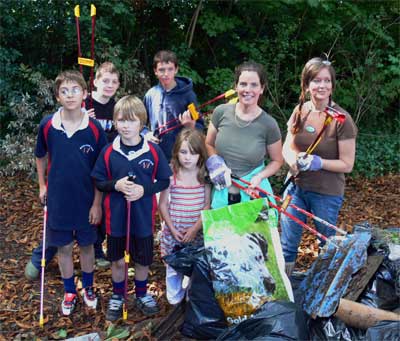Five rules for successful community committees
- Complaining about the Mainland - 17th August, 2024
- New island designation – is it just greenwash? - 26th April, 2024
- Police and Crime Commissioners – a solution or a problem? - 21st April, 2024
The scene: 7.30pm, a draughty community building where all the chairs are too small. The event: an inaugural meeting of the Friends of Anytown Country Park. The cast: a group of keen local worthies ready to start their community project – probably with some grant or other on the horizon. The villain: a dismal local council ranger thinking of his supper…

It’s not an uncommon scene. And I’ve been to a few of them. Actually, it isn’t dismal at all, usually it all turns out fine and it can be a great way to get people out and enjoying their local nature reserve, park or whatever. But there are pitfalls that an ‘organised’ group just seems inevitably to walk into. Maybe it’s just that people who come along and volunteer aren’t experienced in committees and groups, or maybe people are just predictable. But the same problems just seem to come up every time. So just on the off-chance that somebody will listen, and save themselves no end of trouble, here are The Ranger’s five golden rules for community committees – for organisers, rangers and volunteers alike. Rule one: never hold an election unless you’ve already got at least one candidate. This one’s almost too obvious. Don’t even dream of saying “Does anybody want to put themselves forward for the position of…” unless you’ve already primed some mug to step forward. They might be reluctant, but think how much more reluctant they will be if you haven’t spoken to them! Some people might be keen and competent, but not want to push themselves forward in public. So make sure the election is just a formalisation of what you already know. Unless, of course, another decent candidate does come forward – in which case try to make sure you give both of them some kind of job. Never waste a volunteer. There’s another reason for this, too. If the local loony turns up, you don’t want them to step up and get on your new committee unopposed, do you? So prepare your candidates and make sure they are willing to stand. Rule two: don’t get bothered by procedure. People unfamiliar with committees and formalised decision-making can find it off-putting and intimidating. If they’re the ones running the committee this often expresses itself in over-cautious, excessive reliance on procedures and rules. When the chair says “What do we do next…” and looks helpless you’ve got a problem. So try to keep the business as informal as is appropriate. People want to talk about the park – that’s why they are there. So long as it feels fair and any decisions are carefully noted down that will probably do. This is particularly important if you have a people from a range of ages and/or backgrounds – you want to keep everyone feeling interested and involved. Rule three: avoid the Bicycle Shed issue. In his remarkably insightful 1957 book Parkinson’s Law C. Northcote Parkinson describes a committee that met to discuss the construction of a new atomic power plant. The agenda included three items: approving the plans for the plant, discussing a new bicycle shed for employees, and the refreshment expenses of the Welfare Committee. The committee spent two and a half minutes agreeing the highly complex power plant, forty-five minutes lively debate on the bicycle shed, and a furious debate on the refreshments for and hour and a quarter – eventually unresolved with the matter deferred to a further meeting. This tale might be fifty years old but it’s absolutely spot-on and still relevant: all committees really do tend to be like this. Complex, difficult questions are often avoided or dealt with over-quickly; whilst trivial ones expand to become hugely important and time-consuming. Good chairing of the meeting will help to avoid this, but it’s necessary to be concious of it, as it will sometimes feel as though you are stifling debate. Don’t be frightened of doing this. If a decision can easily be made outside of the meeting then just say something like “Mr So-and-so can sort this out and let us know what he decided at the next meeting”. Volunteers’ time is valuable. People have only so much time to offer your committee and most really don’t need to argue about what colour the paper will be, or the layout of the chairs – which brings me on to…

Rule four: don’t design by committee. Some things are definitely not best done by a committee. Most of these are things that can be categorised as ‘design’. So design of the groups logo – NO. Don’t even go there. Design of the new interpretation boards – probably just as bad. Design of the new fencing? Definitely not. This sounds a bit odd – after all, isn’t that what the committee is for deciding? Well, not really. The committee needs to give direction to those who will actually do the work – often the same people. But it is always much better for this to be done by delegating somebody to do the job, and then approving what they did (or not). That way somebody can take the time to research and produce options – you just can’t do that in a committee. So, to take the logo example, when a new logo is needed, the committee should agree that this is a desirable thing, and set some parameters. For example, they can agree that it needs to be easily readable, photocopy well, and contain the words ‘Friends of Anytown Park’. Then they stop debating it, and pass the job to Mrs X. Mrs X comes back at the next meeting with a range of logos. The committee, hopefully, likes one, and chooses one. Or if you’re in a hurry, then just skip the first step and create a range of logos to choose from and take them along to the first meeting. This ensures that everyone gets a say, but also that the committee does not end up debating endlessly on tiny points of detail. Use the same idea for anything that needs designing. Rule five: if you need a professional, get one. Let’s see, your committee needs to agree some public liability insurance. They don’t want to spend much of their hard-won funds on it, so they agree to ask the local school if the children would like to enter a competition to insure the Friends. The prize – a tin of biscuits… An unlikely scenario? Possibly. But if you substitute ‘produce a newsletter’ for ‘arrange insurance’ it’s not too unlikely. In short, if you need professional input, save up and pay for it: do not waste your valuable volunteer goodwill on it. If you’ve got a volunteer who has some appropriate professional experience then great. But if not, bite the bullet, save up and pay for your landscape architect, printer, JCB driver, and skip hire. It will save money in the long run and. more importantly, prevent volunteers from being unfairly used. So when somebody says (and they will) “let’s get the school/college to do it”, then immediately ask yourself the question – is this going to actually benefit the students, or is it just a cheapskate way to get something done without paying for it? If the latter, move along. Actually, involving the local school is a really great idea, although it will take a lot of time and commitment from you to make it work properly. But don’t ever agree to ‘do a competition’ or whatever until you have spoken to the head or a sympathetic teacher. Before you make any decisions ask them how they want to be involved. You will get a much more useful answer than if you decide for them. And actually, teachers are pretty creative and resourceful people, so they will probably have some good ideas! Now go out and get involved! And let’s hear your own ‘golden rules’.

